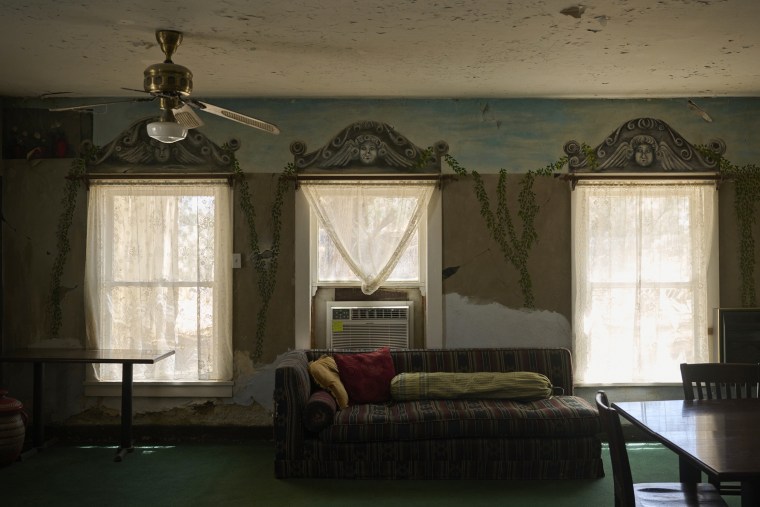It was easier for Cathy McCorkle to get the stent operation that saved her life than it has been to get financial assistance to replace her busted central air conditioning unit.
She suffered a heart attack in late July, right around the time her hometown, Mount Holly, North Carolina, was experiencing temperatures in the mid-90s. Her AC system has been out of action since the spring, meanwhile. She, like 2,000 other state residents, is awaiting approval for aid through a community advocacy program.
McCorkle, a 65-year-old retired school bus driver and cafeteria worker, said she can’t afford the $12,000 expense to replace the system on her $2,200 fixed monthly income. The unit also provides heat. So as autumn and winter approach, she’s worried about the cold.
“I don’t have the money to get a new unit, and the wintertime is coming up,” she said. “I just don’t know what I’m gonna do.”
Increasingly extreme and volatile weather has turned air conditioning into a more crucial utility for more consumers in different regions of the U.S. Last weekend, for instance, parts of typically mild San Diego soared to nearly 110 degrees, breaking decades-old records. This has forced aid groups to stretch their dollars further to help.
But many groups say federal budget cuts have tied their hands: Since funding for the Low Income Home Energy Assistance Program (LIHEAP) was slashed to $4.1 billion this fiscal year from $6.1 billion in the last one, nearly 1 million fewer households have received help with heating and cooling needs, according to the National Energy Assistance Directors Association (NEADA) and the Center for Energy Poverty and Climate.
Resumed funding for LIHEAP is dependent on an appropriations bill used to fund the government. If Congress, facing a Sept. 30 deadline, instead passes a stopgap measure, the program would receive an allocation that could fund it for six months or less. But LIHEAP administrators won’t know their total funding — or full capabilities for assistance — until a full-year spending bill is passed, said Mark Wolfe, executive director for NEADA, which represents state administrators of the LIHEAP.
“There’s just less money to help families pay their utility bills,” said Wolfe, whose group projects at least 3.5 million households will experience a shut-off this year. LIHEAP was originally created to help low-income residents keep their heat on during the winter, but advocates are calling for the restoration of the more than $2 billion CARES Act-era supplement — and a $1 billion boost for emergency assistance — so that their coffers are more commensurate with shifting climes. The average cost of cooling an American home from June to September is set to hit $719, nearly 8% higher than last year, according to NEADA, the highest level in a decade.
 An air conditioning unit sits in the window of the hotel lobby at Amargosa Opera House in Death Valley, Calif., on Aug. 6.Bridget Bennett / The Washington Post via Getty Images
An air conditioning unit sits in the window of the hotel lobby at Amargosa Opera House in Death Valley, Calif., on Aug. 6.Bridget Bennett / The Washington Post via Getty ImagesIn Washington state, administrators “still have people asking for ACs,” said Brian Sarensen, who manages the program within the state Commerce Department. But those requests are on hold: The program closed its doors on July 31, Sarensen said, marking the first time in four years it did not run year-round.
Washington is not typically known for scorching weather, unlike, say, Phoenix, where temperatures hit 100 degrees for the 100th straight day last week. But last week also saw a triple-digit heat wave descend onto southwest Washington and parts of Oregon. Sarensen’s team wasn’t around to offer help.
“We had calls during our latest heat wave, and our agencies just don’t have the LIHEAP funding,” Sarensen said. “The pandemic-era funding is gone.”
Thanks to some creative budgeting strategies — such as renaming its subsidy from “cooling benefit” to “other emergency service” so that they could send residents ACs in the fall, when they’re cheaper — Sarensen said the program helped 91,000 households this fiscal year. That’s close to the 100,000 it reached the year before with the additional $30 million in CARES Act funding. Before that, it was about 65,000.
“It’s just the reality of running a program that can’t serve 100% of the eligible population, and every state deals with the exact same thing,” Sarensen said.
In North Carolina, agencies are also turning to other options to support their operations. When LIHEAP funding ran out for the Blue Ridge Community Action — where McCorkle applied for assistance to replace her central air conditioning unit — the group turned to a weatherization program included in the Bipartisan Infrastructure Law. But that process is on pause, too, said Stephanie Ashley, the group’s executive director. The state’s energy department readjusted its county funding allotment based on heating needs rather than the number of residents who meet the income threshold.
“We’ve done the energy audit,” said Ashley, who estimated about 560 households are on her waitlist for home weatherization assistance. “We’ve got the work orders. We’re ready to go; we’re just waiting to get an executed contract from the state office.”
LIHEAP administrators in many states have been flagging rising temperatures as another reason why the program should be governed the same as a safety-net program, such as Medicaid or SNAP. Unlike those so-called entitlements, LIHEAP funding can be depleted without helping everyone who qualifies. It also means that its effectiveness is far more vulnerable to the political whims of Washington, D.C.
“I don’t think there’s any taste at a federal level to open up a federal statute that guarantees services during this particular political time,” Sarensen said. House Republicans hold a narrow majority, as they did during last year’s government funding negotiations, when they unsuccessfully attempted to decimate LIHEAP by 70% as part of a plan to “end the wasteful spending that the Democrats have put forth.”
“Nothing’s going to happen until after the election,” Sarensen said.
Neither Vice President Kamala Harris nor former President Donald Trump has mentioned direct utility or weatherization aid in their campaigns for the White House. More than 3.4 million households have claimed tax credits included in the Inflation Reduction Act to invest in home-energy upgrades, according to the U.S. Treasury Department, but that, too, has been a slow rollout, Wolfe said.
In the meantime, policymakers and utility regulators should look to other contingencies such as implementing seasonal shut-offs protections and expanding access to income-based utility rates, said Karen Lusson, senior attorney at the National Consumer Law Center.
“Why as a society, if we acknowledge that access to utility service is essential for daily life, do we continue to have policies that permit disconnections of households simply because they can’t afford to pay their bill?” she added.
.png)
 6 days ago
9
6 days ago
9




























 Bengali (BD) ·
Bengali (BD) ·  English (US) ·
English (US) ·